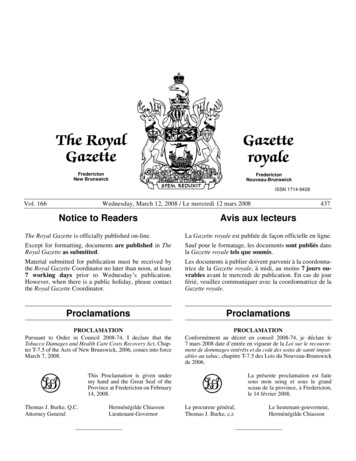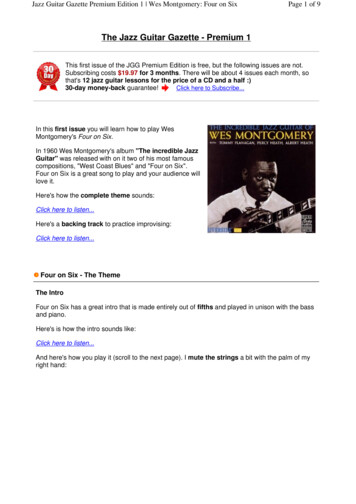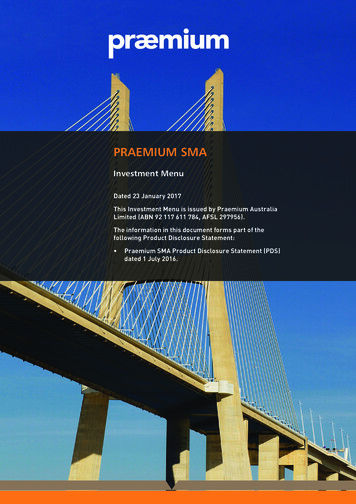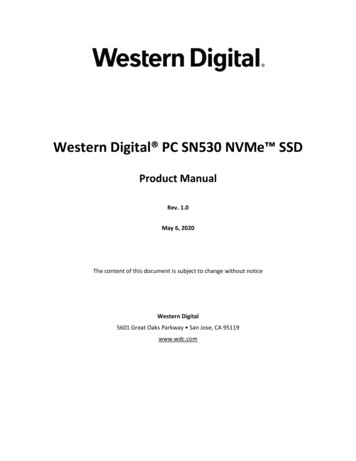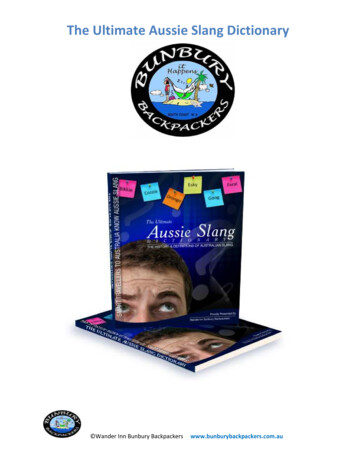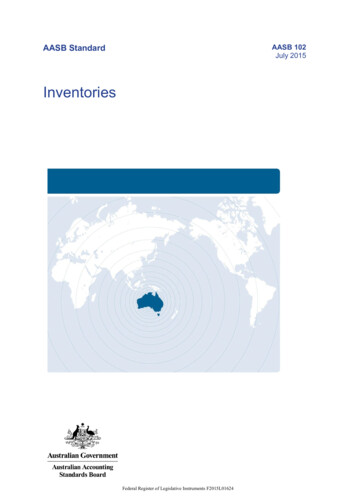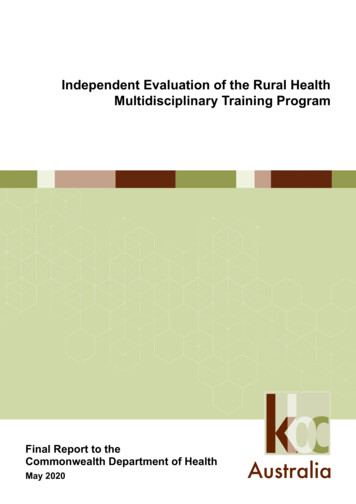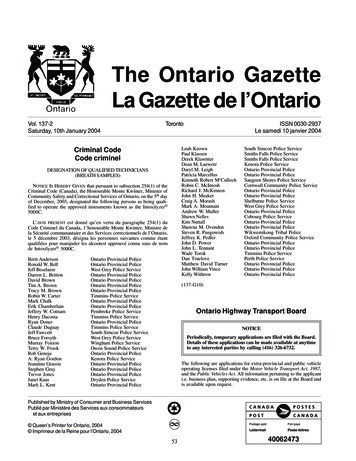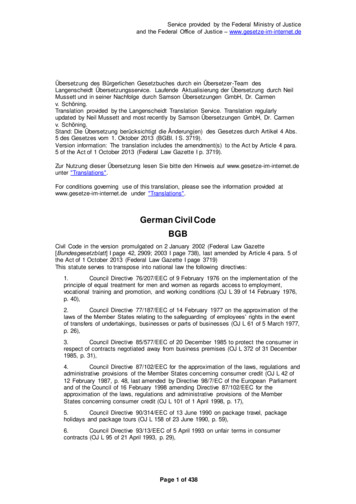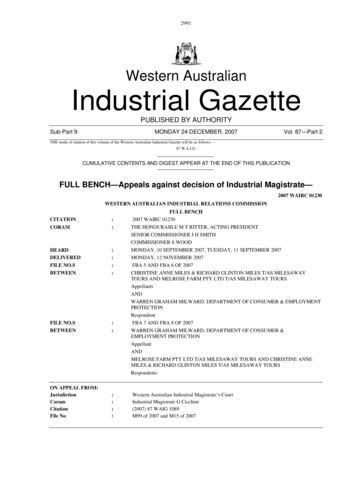
Transcription
2991Western AustralianIndustrial GazettePUBLISHED BY AUTHORITYSub-Part 9MONDAY 24 DECEMBER, 2007Vol. 87—Part 2THE mode of citation of this volume of the Western Australian Industrial Gazette will be as follows:—87 W.A.I.G.CUMULATIVE CONTENTS AND DIGEST APPEAR AT THE END OF THIS PUBLICATIONFULL BENCH—Appeals against decision of Industrial Magistrate—2007 WAIRC 01230WESTERN AUSTRALIAN INDUSTRIAL RELATIONS COMMISSIONCITATIONCORAM::HEARDDELIVEREDFILE NO.SBETWEEN::::FILE NO.S:BETWEEN:ON APPEAL FROM:JurisdictionCoramCitationFile No::::FULL BENCH2007 WAIRC 01230THE HONOURABLE M T RITTER, ACTING PRESIDENTSENIOR COMMISSIONER J H SMITHCOMMISSIONER S WOODMONDAY, 10 SEPTEMBER 2007, TUESDAY, 11 SEPTEMBER 2007MONDAY, 12 NOVEMBER 2007FBA 5 AND FBA 6 OF 2007CHRISTINE ANNE MILES & RICHARD GLINTON MILES T/AS MILESAWAYTOURS AND MELROSE FARM PTY LTD T/AS MILESAWAY TOURSAppellantsANDWARREN GRAHAM MILWARD, DEPARTMENT OF CONSUMER & EMPLOYMENTPROTECTIONRespondentFBA 7 AND FBA 8 OF 2007WARREN GRAHAM MILWARD, DEPARTMENT OF CONSUMER &EMPLOYMENT PROTECTIONAppellantANDMELROSE FARM PTY LTD T/AS MILESAWAY TOURS AND CHRISTINE ANNEMILES & RICHARD GLINTON MILES T/AS MILESAWAY TOURSRespondentsWestern Australian Industrial Magistrate’s CourtIndustrial Magistrate G Cicchini(2007) 87 WAIG 1089M99 of 2007 and M15 of 2007
2992WESTERN AUSTRALIAN INDUSTRIAL GAZETTE87 W.A.I.G.CatchWords:Industrial Law (WA) - Appeal against decision of Industrial Magistrate’s Court - Alleged breach of Transport Workers (PassengerVehicles) Award 1978 - Claim pursuant to s83(1) Industrial Relations Act 1979 (WA) - Claimant appointed under Public SectorManagement Act 1994 (WA) - Whether the award applied to an industry or to a vocation - Employed as a bus driver or a tour guide- Validity of appointment as industrial officer under Public Sector Management Act - Meaning of industry or industries to which theaward applied - Appointment of industrial inspector - Appointment of public service officers other than executive officers Whether Claimant was a casual employee under the award - Indicia of casual employment - Test of “Centurion Industries” Context specific nature of a casual worker, casual employee or casual employment - Determining casual worker status under theaward - Concept of “as and when required” as part of casual employment - Meaning of “engaged and paid as such” as part ofcasual employment - Whether the de-facto officers doctrine applied - Whether Claimant had “colourable title” to the office Application of presumption of regularity test - Whether there was underpayment of wages - Whether failure to pay rate of wageprescribed by the award is a continuing breach - When the obligation to pay a casual worker arises - Payment of pre-judgementinterest, disbursements, penalty for breach and amount due - Appeals 5 and 6 of 2007 dismissed - Appeals 7 and 8 of 2007allowed.Legislation:Industrial Relations Act 1979 (WA) (as amended), s7, s35, s37(1), s81A, s81AA, s81CA(2), s82A, s83, s83(3), s83A, s85, s98,s113(3), s114Public Sector Management Act 1994 (WA), s3(1), s5, s64, s65(1)Acts Amendment and Repeal (Industrial Relations) (No 2) Act 1984 (Act 92 of 1984), s6Criminal Procedure Act 1986 (NSW), s126Financial Management Act 2006, s3Industrial Arbitration Act 1912-1925, s40Industrial Arbitration Act 1979 (WA)Industrial Conciliation and Arbitration Act 1900 (WA)Industrial Relations Act 1988 (Cth)Industrial Magistrates Courts (General Jurisdiction) Regulations 2005, regulation 12(4)Long Service Leave Act 1967 (SA), s5(1)Magistrates Court (Civil Procedure) Act 2004, Part 2Transport Act 1930 (NSW), s101, s123Transport Workers (Passenger Vehicles) Award 1978Workers’ Compensation Act 1926-1929 (NSW)Workmens’ Compensation Act 1906Workplace Relations Regulations 1989Result:Appeals No FBA 5 and 6 of 2007 dismissedAppeals No FBA 7 and 8 of 2007 allowedRepresentation (FBA 5 and FBA 6 of 2007):Counsel:Appellant:Mr G McCorry, as agentRespondent:Mr R Andretich, (of Counsel) and with him Mr A Shuy, (of Counsel)Solicitors:Respondent:State Solicitor’s OfficeRepresentation (FBA 7 and FBA 8 of 2007):Counsel:Appellant:Mr R Andretich, (of Counsel) and with him Mr A Shuy, (of Counsel)Respondent:Mr G McCorry, as agentSolicitors:Appellant:State Solicitor’s Office
87 W.A.I.G.WESTERN AUSTRALIAN INDUSTRIAL GAZETTE2993Case(s) referred to in reasons:Alestalo v Steves Nedlands Park Nominees Pty Ltd (1997) 77 WAIG 499Amalgamated Engineers v Parker & Son (1926) 6 WAIG 377Amcor Limited v The Construction, Forestry, Mining and Energy Union and Others (2005) 214 ALR 56AMIUE (QLD Branch) v Inghams Enterprises Pty Ltd (2002) QGIG 153Anthony & Sons Pty Ltd T/as Oceanic Cruises v Fowler (2005) 85 WAIG 1899Australian Shipbuilding Industry (WA) Pty Ltd v Maritime Workers’ Union (1977) 57 WAIG 458 (ASI)Award Simplification Decision (1997) 75 IR 272Bernardino v Abbott [2004] NSWSC 430 (NSW SC)BHP Billiton Iron Ore Pty Ltd v Automotive, Food, Metals, Engineering, Printing and Kindred Industries Place Union of Workers(Western Australian Branch) & Others (2006) 86 WAIG 1477; [2006] WASCA 124Bluesuits Pty Ltd t/as Toongabbie Hotel v Graham (1999) 101 IR 28Bond v R (2000) 201 CLR 213Cassell v The Queen (2000) 201 CLR 189Cetin v Ripon Pty Ltd t/as Parkview Hotel (2003) 127 IR 205 (AIRC)City of Wanneroo v Holmes (1989) 30 IR 362 at 378Clarkin V B. and P. Delvizis and B and L Petridis T/as Terrace Café T56 Myer, (1994) 61 SAIR 364Connelly v Wells (1994) 55 IR 73Dorant v JLV Industries (1996) 76 WAIG 440Doropoulos v TWU (1989) 69 WAIG 1290Doyle v Sydney Steel Company Ltd (1936) 56 CLR 545Farrar v Nationwide Oil Pty Ltd (2001) 167 QGIG 103 (QIRC)Federated Clerk’s Union v Cary (1977) 57 WAIG 585Federated Clerks Union of Australia, Industrial Union of Workers, WA Branch v Automatic Totalisators Ltd (Sloan’s Case) (1978)58 WAIG 1452Fowler v Anthony & Sons Pty Ltd T/as Oceanic Cruises (2004) 84 WAIG 3855Foy v The Directors of Terraqua Pty Ltd (2003) 83 WAIG 3319G J Coles and Company Ltd v Retail Trade Industrial Tribunal (1986) 7 NSWLR 503Gibson & Roberts v Chubb Security Services Ltd (2004) 84 WAIG 3798Hamzy v Tricon International Restaurants and Another (2001) 115 FCR 78Holt v Pemberton Hotel (1997) 77 WAIG 2773Howe and Kosier v Hutt Street Private Hospital (1987) 25 IR 356, 54 SAIR 423J and A Transport Pty Ltd v Siostrom (1998) 78 IR 109James Turner Roofing Pty Ltd v Peters (IAC) (2003) 132 IR 122; (2003) 83 WAIG 427; [2003] WASCA 28James Turner Roofing v Peters (2002) 82 WAIG 765Jamieson v Jadebay Corporation t/as Ezi-Gro Orchids (2001) 81 WAIG 2586Jamieson v McKenna [2002] WASCA 325Julia Ross Personnel v Wain (2001) 166 QGIG 350Knight v Bucknill (1913) 6 BWCC 160Kucks v CSR Ltd (1996) 66 IR 182Licensed Clubs Association of Victoria and Another v Higgins (1988) 4 VIR 43Loves Bus and Taxi Service v Zucchiatti (2006) 157 IR 348; 86 WAIG 3351Luff v Oakley (1986) 82 FLR 91; 65 ACTR 19MacCarron v Coles Supermarkets Australia Pty Ltd (2001) 23 WAR 355; [2001] WASCA 61McLaren v The Corporation of the City of Adelaide (1991) 58 SAIR 557Metals & Engineering Workers Union, Western Australia v Centurion Industries Ltd (1996) 76 WAIG 1287; 66 IR 312Metropolitan and South-Western Engine-Drivers’ Union of Workers v The Timber Corporation (1910) 9 WAAR 11
2994WESTERN AUSTRALIAN INDUSTRIAL GAZETTE87 W.A.I.G.Metropolitan Shop Assistants’ and Warehouse Employees’ Industrial Union of Workers v Foy & Gibson Pty Ltd (1912) 11 WAAR113Nightingale v Little Legends Childcare (2004) 134 IR 111Norwest Beef Industries Ltd v Australasian Meat Industry Employees’ Union (WA Branch) (1984) 12 IR 314; 64 WAIG 2124Parker and Son v Amalgamated Society of Engineers (1926) 29 WALR 90Peeters v Sunshine General Industries Pty Ltd (1997) 77 WAIG 3493Personnel Contracting Pty Ltd t/as Tricord Personnel v Construction, Forestry, Mining and Energy Union of Workers (2004)141 IR 31Port Noarlunga Hotel v Stewart (1981) 48 SAIR 220R v Cawthorne; Ex parte Public Service Association of South Australia Inc (1977) 17 SASR 321R v Janceski (2005) 223 ALR 580Re Coastal Districts Clerks’ Union (1913) 12 WAAR 26Reed v Blue Line Cruises Limited (1996) 73 IR 420 (IRCA)Robe River Iron Associates v Amalgamated Metal Workers’ and Shipwrights Union of Western Australia (1987) 67 WAIG 1097Ruby v Marsh (1975) 132 CLR 642; [1975] HCA 32Rushton and Cairns v The Western Australian Turf Club and the Chairman of the Committee of The Western Australian Turf Club(2001) 81 WAIG 868Ryde–Eastwood Leagues Club Ltd v Taylor (1994) 56 IR 385Serco v Moreno (1996) 76 WAIG 937; 65 IR 145Shugg v The Commissioner for Road Transport and Tramways (New South Wales) (1937) 57 CLR 485Silberschneider v MRSA Earthmoving Pty Ltd (1988) 68 WAIG 1004South Australia v Tanner (1989) 166 CLR 161; [1989] HCA 3Squirrell v Bibra Lakes Adventure World Pty Ltd (1984) 64 WAIG 1834Stoker v Wortham [1919] 1 KB 499Stone v Varrone Plastering Pty Ltd (2000) 80 WAIG 1968The Western Australian Carpenters and Joiners, Bricklayers and Stoneworkers Industrial Union of Workers v Terry Glover Pty Ltd(1970) 50 WAIG 704TWU v Pinnacle Services Pty Ltd (1999) 79 WAIG 3567United Construction Pty Ltd v Birighitti (2003) 83 WAIG 434United Transport Services Pty Ltd v Evans [1992] 1 VR 240Wilton v Coal & Allied Operations Pty Ltd (2007) 162 IR 264 (FCA)Yamasa Seafood Australia Pty Ltd v Watkins [2000] VSC 156Case(s) also cited:Brammer v Deery Hotels Pty Ltd (1974) 22 FLR 276Environmental Protection Authority v Alkem Drums Pty Ltd [1999] NSWLEC 26Ingamells v Petroff (1934) 50 CLR 451Jones v Lorne Sawmills Pty Ltd (1923) VLR 58R v Industrial Appeals Court; Ex parte Barelli’s Bakeries Pty Ltd (1965) VR 615Transport Workers Union v D B & B Adams & Ors (1980) 60 WAIG 870Zucchiatti v Loves Bus and Taxi Service (2006) WAIRC 04564Reasons for DecisionRITTER AP:The Appeals1There are four appeals before the Full Bench. Each of them has been instituted pursuant to s84 of the Industrial Relations Act1979 (WA) (the Act). The appeals involve two decisions of the Industrial Magistrate’s Court. The decisions were thedetermination of two originating claims before the Court which were numbered M99/2006 and M15/2007. There is an appealby each of the claimant and the respondent against the decisions on each of the originating claims.
87 W.A.I.G.WESTERN AUSTRALIAN INDUSTRIAL GAZETTE29952In both originating claims the claimant was named as “Warren Graham Milward, Department of Consumer and EmploymentProtection”. In M99/2006 the respondent was named as “Melrose Farm Pty Ltd t/as Milesaway Tours”. In M15/2007 therespondent was named as “Christine Anne Miles and Richard Glinton Miles t/as Milesaway Tours”. Each of the respondentstraded as Milesaway Tours. Both claims were heard together.3Both originating claims alleged Milesaway Tours had breached the Transport Workers (Passenger Vehicles) Award 1978 bythe underpayment, between January 2001 and June 2004, of Mr Gregory John Sladden a former employee bus driver. Theclaims sought the imposition of penalties and the payment of the amount of the underpayment to the former employee.4As stated each party filed an appeal against both of the sets of final orders issued by the Industrial Magistrate’s Court. Whilstthis was entirely appropriate, it meant there was a duplication of issues across the four appeals, which did not need to beconsidered separately in each appeal.5For ease of reference I will refer to the claimant at first instance and the appellant in appeals 7 and 8 as “Mr Milward”. I willrefer to the appellant in appeals 5 and 6 and respondent in appeals 7 and 8 as “Milesaway”.The Final Orders6Final orders on each claim were made and were published on 23 May 2007.7In M99/2006 the final orders were:-8“1.Judgment for the claimant against the respondent.2.There is a finding that the respondent has committed 88 breaches ofthe Transport Workers (Passenger Vehicles) Award 1978.3.The respondent shall pay a penalty of 45.00 for each breachamounting to 3,960.00 payable to Consolidated Revenue.4.The respondent shall pay to Gregory John Sladden 15,478.01.5.The claims for interest and disbursements are dismissed.”In M15/2007 the final orders were:“1.Judgement for the Claimant against the Respondents.2.There is a finding that the Respondents breached the TransportWorkers (Passenger Vehicles) Award 1978 on 77 separate occasions.3.The Respondents shall pay a penalty of 30.00 for each breachamounting to 2,310.00 which shall be paid into consolidatedrevenue.4.The Respondents shall pay to Gregory John Sladden 12,344.36.5.The claims for interest and disbursement are dismissed.”Proceedings Before the Industrial Magistrate’s Court9Originating claim M99/06 was filed on 28 September 2006 and M15/07 was filed on 2 February 2007, with particulars ofclaim annexed. The particulars were in substantially similar terms with necessary changes because of the different legalpersona of the respondent, the dates within which Mr Sladden was employed by that respondent, the rates he was paid andunderpayments alleged.(a)Particulars of Claim10 The particulars of claim commonly claimed or sought:(i)Mr Milward was an industrial inspector appointed under and subject to Part 3 of the Public SectorManagement Act 1994 (WA) (the PSMA).(ii)The claim was made pursuant to s83(1) of the Act.(iii)Milesaway operated a tour and charter business in and around the winery region from Busselton in WesternAustralia.(iv)Milesaway employed Mr Sladden as a casual bus driver from 24 January 2001 to 31 July 2002 (as apartnership) and 1 August 2002 to 30 June 2004 (as a corporation).(v)Mr Sladden was engaged as a bus driver and as such his employment with the respondent was bound by theTransport Workers’ (Passenger Vehicles) Award No R 47 of 1978 (the award).(vi)Mr Sladden at all times drove a bus with less than 25 adult passengers as specified in clause 10(1)(a) of theaward.(vii)Mr Sladden was at all material times an adult for the purposes of the award.(viii)Mr Sladden’s rates of pay were set out.
2996WESTERN AUSTRALIAN INDUSTRIAL GAZETTE87 W.A.I.G.(ix)Milesaway failed at various times to pay Mr Sladden, as a casual employee, the correct rate of pay inaccordance with clauses 6(2), 6(3), 6(4), 6(5), 6(6) and 6(9) of the award being payments for ordinary hours,overtime, hours worked on a Saturday, hours worked on a Sunday, hours worked on a Public Holiday andhours worked at night.(x)Claim M99/2006 asserted underpayment of Mr Sladden on 303 occasions. Claim M15/2007 assertedunderpayment of Mr Sladden on 244 occasions.(xi)In Claim M99/2006 an order was sought that Milesaway pay to Mr Sladden outstanding wage entitlementsof 15,478.01. In Claim M15/2007 an order was sought that Milesaway pay to Mr Sladden outstandingwage entitlements of 12,363.72.(xii)In each claim there was also an order sought for payment of “pre judgement interest”, disbursements and apenalty for the breaches of the award.11 Attached to each filed claim were printed documents which purported to set out the amounts of the underpayments. Includedon the documents were the dates and times when Mr Sladden worked.12 The way in which Mr Milward structured the claims meant that to succeed in proving each breach and underpayment, it wasnecessary to establish that Mr Sladden was employed as a casual worker by Milesaway and the employment was covered bythe award.(b)Particulars of Defence13 Milesaway filed two identical particulars of defence on 14 February 2007. The particulars of defence were in the form of apleading to each of the paragraphs of the particulars of claim. The effect of the particulars of defence was that the followingwere in issue and/or asserted:(i)Whether Mr Milward was an industrial inspector.(ii)Whether the respondent operated a tour and charter business. It was claimed it was a tour business.(iii)Whether Mr Sladden was employed as a bus driver. It was claimed he was a tour guide.(iv)Whether Mr Sladden’s employment was subject to the provisions of the award.(v)Milesaway did not admit the rates of pay of Mr Sladden as Mr Milward had possession and control of theirrecords about the payments to Mr Sladden.(vi)Milesaway were not under an obligation to pay Mr Sladden the amounts claimed because the award did notapply to their business.The Hearing(a)Witnesses14 The claims proceeded to a hearing on 21 and 22 February 2007 and 2 May 2007.15 The following witnesses gave evidence in support of the claims:-(b)(i)Mr Michael Holmes, a public servant.(ii)Mr Adam Howard, a former industrial inspector.(iii)Mr Gregory Logan-Scales, an industrial inspector.(iv)Mr Gregory Sladden, the employee whose payment was the subject of the claims.(v)Mr Warren Milward, the complainant.(vi)Mr Jeffrey Radisich, the former Executive Director of the Labour Relations Division of the Department ofConsumer and Employment Protection and since February 2006 the Director of the Western Operations ofthe Australian Building and Construction Commission.Relevant Evidence of Mr Sladden16 As will be set out later, the evidence about the type of employment Mr Sladden had with Milesaway is important in decidingone of Milesaway’s grounds of appeal. The relevant evidence of Mr Sladden was:(i)Mr Sladden answered an advertisement that Milesaway placed in the Busselton-Margaret River Times on7 December 2000. (T35, exhibit 17). The text of the advertisement was:“Tour Guide DriverMust have ‘F’ class licence, Senior First Aid Cert. Casual positioninvolving weekend work. Past applicants need not apply.(Phone) 9754 2929 eveningsMilesaway Tours”(ii)Mr Sladden had an interview with Mr Richard (Rick) Miles. He was told the position was “casual”. Ifsuccessful he would be required to do a trial run to see if he liked the job and then three training runs at hisown expense to train for the job. (T36).
87 W.A.I.G.WESTERN AUSTRALIAN INDUSTRIAL GAZETTE2997(iii)A few days after the interview Mr Sladden received a telephone call from a woman whose name he did notrecall and was told “that I could have the job – was I interested in doing a trial run ”. Mr Sladden said hewould and then arranged to meet a driver to go out for the day on a tour. (T36).(iv)Mr Sladden then went to the premises of Milesaway and met “Tanya”. After conversations between MrSladden, Tanya and Mrs Christine Miles it was agreed that Mr Sladden would do a training run and not atrial run with Tanya. (T36/37).(v)After the training run with Tanya, Mr Sladden did two other training runs with different drivers. (T39).(vi)Mr Miles did not at any stage sign an employment contract. (T37).(vii)After the three training runs, Mr Sladden did his first solo run. He met Mrs Miles who showed him how tocheck the vehicle and make up a cheeseboard for the wine tour. He was also shown the booking documents.(T41).(viii)Mr Sladden drove and provided commentary for the Milesaway wine tours but not canoe tours. He also didCharters, taking people to a destination without commentary and transfers. Transfers were simply themovement of passengers from one point to another.(ix)Mr Sladden also said that he was at times “called in” just to clean buses and on a couple of occasions didwhat he called a brochure run. There, he drove throughout the Margaret River wine region topping upbrochures at venues. (T43).(x)Mr Sladden had additional training in mid 2001. Procedures were introduced whereby drivers had to do aninspection of vehicles as laid out in a book presented to the drivers. The driver’s manual containedprocedures and instructions which they were required to sign and hand back to management. The driverswere also required to do a driver fatigue examination or certificate on the internet. (T39).(xi)From around June 2001, daily vehicle checks were made and recorded in books kept in the buses. Thiscontinued until Mr Sladden’s cessation of employment. (T40).(xii)After giving details of what the bus driving involved, Mr Sladden was asked: “How would you bereallocated another job or shift?”. Mr Sladden answered: “Generally, when you arrived into the depot,once you finished you’d would phone into the office, and it was generally Christine Miles that you spoke to.It would be then told what you would be doing the next day, or the next shift.” (T42).(xiii)When later asked about allocation of shifts, Mr Sladden said this occurred by “the phone call when youarrived in the night before. You would phone in to the office and then you were told what you would bedoing the next day”. (T47).(xiv)Mr Miles was asked “how would you know that you had to do a transfer as part of your employment”. Heanswered: “You were told by whoever told you what you were doing that day”. (T43).(xv)The charter runs came about by Mr Sladden telephoning “into the office and you maybe advised, tomorrowyou’re doing a charter.” (T42).(xvi)The rate of pay was the same for every job Mr Miles did and it was a flat rate of pay per hour without anypayment of overtime, penalties or minimum hours. (T43).(xvii) Mr Sladden said that consistently with what he was told by Mr Miles at his interview (T36) he thought hisrate of pay was determined by the award. (T44). On two occasions Mr Sladden was told by “Sharon, thesecretary” that there had been increases in the rate of pay because the award rate had increased. Mr Sladdensaid Sharon also said “we are all being paid illegally – something should be done about it. When I said‘What does that mean?’ she said the hours we are working we should be on permanent employment. Itwasn’t long after this that I believe that Sharon took herself off being casual to actually being paidpermanent employment”. (T44).(xviii) Mr Sladden said he did not speak to his employer about the rate of pay and would not have been game to doso because of Mr Miles’ temperament. (T44).(xix)Mr Miles was asked how many hours per week he worked on average. He said that his “week could be onetour, two tours, up to seven days.” (T44). He said he averaged about 35 hours per week. Mr Sladden alsosaid that during school term he taught music and generally did not work on a Wednesday. His hours wouldvary from week to week from 15 – 20 hours to around 60 hours. (T44).(xx)Asked what days he “typically” worked, Mr Sladden said “typical was always weekends; Thursdays; itreally varied. I could often work Monday, Tuesday but generally the Wednesday I had off because ofteaching. I would work any day, but it was always weekends”. (T44). Mr Sladden also said he would attimes work more than one shift per day. (T44).(xxi)In consultation with Mrs Miles, Mr Sladden developed and then drove a scenic tour. (T45). He said “thescenic tour was every Thursday. But as the tour grew – it became quite a successful tour – as it grew, therewas times when – because the bus I was using then was the Toyota, which was 22 seaters. When we hadmore than that, another driver would be used to drive the larger buses to conduct the scenic tour, becausefor some unknown reason I was not permitted to drive the larger buses.” (T46).
2998WESTERN AUSTRALIAN INDUSTRIAL GAZETTE87 W.A.I.G.(xxii) In cross-examination Mr Sladden said he did a lot of work on Thursdays, Saturdays and Sundays butworked on the other days too. Thursday was very consistent because it was the scenic tour. (T55).(xxiii) Mostly Mr Sladden commenced work in the morning. (T56).(xxiv) The time and wages records of Milesaway for Mr Sladden were received as exhibit 5 during the evidence ofMr Howard. (Additionally as I said earlier the particulars of claim attached a week by week list of thedates, hours and payments made to Mr Sladden. The list was accepted as accurate by the IndustrialMagistrate and there is, at least following the abandonment of ground 3 in the Milesaway appeal, nochallenge to this finding. The list is discussed below.)(xxv) At the beginning of his employment Mr Sladden was paid by cheque on Mondays but this was changed toTuesdays not long after.(xxvi) Mr Sladden’s employment ended in October 2004. In May of that year, he was charged with driving (hisown vehicle and not involving his employment) with a blood alcohol content in excess of 0.08%. This wentto court in July 2004 when he was suspended from driving. Mr Sladden said he did a little bit of work forMilesaway during his suspension. He went out on one occasion with Mrs Miles driving, and didcommentary. On another occasion after Mr Sladden obtained an extraordinary driver’s license, hetransferred some luggage in his own vehicle from the airport to an accommodation house. Mr Sladden alsoassisted with cleaning buses in the depot and did one run with a new driver which was essentially a trainingrun for that driver. (T48/49).(xxvii) During the period of his suspension, Mr Sladden discussed his position with Mrs Miles and was told thatinsurance premiums would increase because of his conviction. Therefore if he wanted to drive after hissuspension he would be required to pay a 1,000 bond. Mr Sladden then said he asked Mrs Miles for aseparation certificate which she gave him so that he could claim unemployment benefits.(xxviii) Mr Sladden’s separation certificate (exhibit 9) recorded that Mr Sladden had been employed by Milesawayfrom 27 November 2001 until 9 May 2004. It was not clear why the separation certificate nominated 9 Mayas the last day of work.17 The week by week list I referred to in (xxiv) covered the period from the week commencing Monday, 22 January 2001 to theweek ending Sunday, 20 June 2004. This period totals 178 weeks. Mr Sladden did not work at all in 11 of these weeks.Additionally in the six weeks from 10 May to 20 June 2004 Mr Sladden only worked two days. This might have been becauseMr Sladden was by then being charged albeit not yet convicted of the driving under the influence offence. A calendar settingout the days worked, on a week by week basis, according to the schedules to the particulars of claim, is attached as Schedule 1to these reasons. The shaded dates are those on which Mr Sladden worked.18 The table below sets out the total number of the days of the week worked over the 178 week period, according to the calendar:Day of the NDAYTotal days worked2731411357614212819 The calendar and table confirm Mr Sladden’s evidence that he did not always work on the same days but he worked mostly onThursday, Saturday and Sundays and much less often on Wednesdays.20 The total number of days worked, as shown on the table, is 580 out of the 1,246 (178 x 7) days during the 178 week period. Inconsidering the table however it is more representative to discount the last 43 days or 6 weeks during which Mr Sladden onlyworked two days. According to the schedule to the particulars of claim, Mr Sladden worked an average of 24.53 hours overthe whole 178 week period, including the 11 weeks when he did not work.(c)Milesaway’s Lack of Evidence21 At the conclusion of the evidence of Mr Radisich, the agent for Milesaway informed the court that he wished to make asubmission of no case to answer. The court was also informed that if the no case submission was not successful, Milesawayelected not to call evidence.(d)The Submissions of Milesaway22 The Industrial Magistrate adjourned for the purpose of reading written submissions which had been prepared by both parties,and then heard oral submissions. The relevant submissions of the agent for Milesaway were:(i)The evidence did not establish that Mr Sladden’s major and substantial duties were to drive a bus, so theaward did not apply to his employment.(ii)Mr Milward had not established the award applied to the employment of Mr Sladden. This was becausethere was no such thing, at law, as a vocational award which could apply to bus drivers. Mr Milward was
87 W.A.I.G.WESTERN AUSTRALIAN INDUSTRIAL GAZETTE2999required to establish the award applied to an industry and the employment of Mr Sladden by Milesaway wasin that industry. It was submitted the award did not on its face or by reference to the respondents of theaward set out what the industry was. Accordingly, some evidence of this was required but none had beenproduced.(iii)In any event, the evidence did not establish that Mr Sladden was employed as a casual employee.(iv)The documents attached to the particulars of claim were not part of the particulars of claim and were notproperly before the court in such a way or supported by evidence so that they could be relied upon.(v)Mr Milward was not competent to bring the proceedings as he had not been validly appointed as anindustrial inspector and the de facto officer’s doctrine did not apply.23 On issue (c), relevant to a ground of appeal Milesaway’s agent submitted:-(e)(i)Mr Sladden worked regularly for four years on Thursdays and weekends generally starting between10am and 12pm.(ii)Mr Sladden worked an average of 35 hours per week except during school holidays.(iii)There was the expectation of continued employment, whether Mr Sladden was going to work on aparticular day or not.(iv)On the “test” of “Centurion Industries” Mr Sladden was not a casual employee. (The reference toCenturion Industries is to the decision of the Full Bench in Metals & Engineering Workers Union,Western Australia v Centurion Industries Ltd (1996) 76 WAIG 1287; 66 IR 312).Mr Milward’s Submissions24 Mr Milward’s counsel made submissions in opposition to each point made by Milesaway’s agent. He maintained the claimsought to succeed. On the casual employment issue he submitted:(i)Mr Sladden was a casual worker under the award.(ii)Under the award a casual worker should receive a loading of 20% in addition to the ordinary rate of pay.Mr Howard gave evidence that the rate of pay of Mr Sladden was generally in line with the award whichincluded the 20% loading. The level of the rate of pay by the employer was therefore that of a casualemployee and not a part-time employee.(iii)Mr Sladden did not receive entitlements that would be given to a part-time worker, such as a pro-rataentitlement to annu
James Turner Roofing Pty Ltd v Peters (IAC) (2003) 132 IR 122; (2003) 83 WAIG 427; [2003] WASCA 28 James Turner Roofing v Peters (2002) 82 WAIG 765 Jamieson v Jadebay Corporation t/as Ezi-Gro Orchids (2001) 81 WAIG 2586 Jamieson v McKenna [2002] WASCA 325 Julia Ross Personnel v Wain (2001) 166 QGIG 350 Knight v Bucknill (1913) 6 BWCC 160
